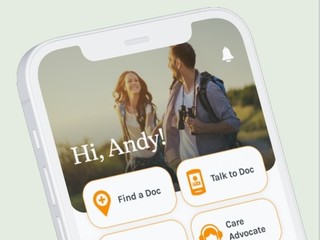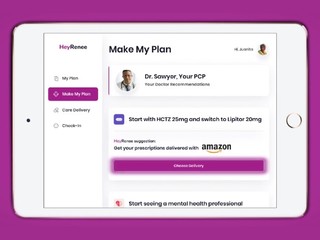

The session was emceed by Mark Goldstein (Chairman, UCSF Health Hub), along with Ryan Helon (Executive Vice President, Rev1 Ventures), David Kereiakes (Partner, Providence Ventures) and Hubert Zajicek (CEO, Co-founder & Partner, Health Wildcatters)
Here are the entrepreneurs that presented:


“At Bone Health, we are passionate about solving one of the most important public health issues that exists in our country, and it’s that of low bone density,” she said, noting that half of all women over the age of 50 will suffer a fracture from osteoporosis, which is more than heart attack, stroke and breast cancer combined, along with one in four men. And these can be deadly: 20% of people who have a hip fracture don’t survive a year.
The problem is there’s very little cure for osteoporosis or osteopenia; the one thing that has been shown to help is high impact exercise, but most of these patients can’t do it.
“Fortunately, there’s a body of evidence done primarily by NASA that showed that whole body vibration improved bone density, but one of the challenges is although the effectiveness was good, it only works if you comply and these platforms are difficult to use and expensive,” she said.
“And so, the founders of Bone Health Technologies invented the Osteoboost, which takes the precise vibration from the whole body vibration platform and is proven there and put it in a convenient and comfortable belt form factor, which makes it easy to use; you strap it on go on your walk, or your chores, and it actually feels good, it feels like a massage. And, most importantly, it targets the vibration to the most vulnerable part of the anatomy: the hip and lumbar spine.”
The device can delay the onset of osteoporosis by more than 20 years, and reduce the risk of fracture 2% for every 1% improvement in bone density.
“We’re providing people with a set of tools that we believe allow them to viably, and safely, pay for their health care expenses outside of traditional health insurance,” he said.
“In fact, my wife, my two girls and I have been uninsured for two years. We’ve used these tools and couldn’t be happier with our healthcare experience.”
CrowdHealth’s belief is that paying cash at the point of sale alleviates doctors from some of the administrative burdens of health insurance, which results in significant savings. That, Schoonover said, probably made him the only participant at the event to advocate for more people being uninsured.
The company raised a $6 million seed round led by Next Coast Venture Partners and Activate Venture Partners in April, and it launched in October.
Mark Hanson, CEO of Decoded Health, which is is developing the world’s first Clinical Hyperautomation Platform that it says can scale physicians and clinical providers by at least 10x.
While there are many things that will improve primary care, Hanson said, including longitudinal health care and patient engagement, “none of that is going to be achievable unless we solve the very critical problem of physician and staff shortages.”
All we’ve done is increase access points, which he likened to adding a drive thru to a Starbucks, “but we haven’t solved for access. And the only way we’re going to do that is by creating more physician supply. Unfortunately, we can’t just magically create more physicians; they take eight years to develop, and then they have to go through residency.”
Decoded Health’s solution for the massive shortage of physicians, and the growing inequity that’s resulting from that, is to create autonomous, virtual, clinically trained, AI, physician extension teams.
“These are autonomous, artificially intelligent, clinically trained, medically knowledgeable, task oriented services that can largely do many of the things that a physician would do in a clinical environment,” he said. That includes performing a clinical patient interview, doing an HPI review of systems in complete natural language, interrogating an EHR, coming up with an explainable differential and explaining that to a physician, doing patient follow-up, and penning orders into the EHR that are that are relevant to that physician.
“Making sure that the physician has all of the critical information that’s going to be required for them to make a decision quickly and efficiently that’s going to enable them to see a much larger patient population and, at the same time, develop deeper relationships with their patients, and ultimately improve access to care and affordability,” said Hanson.

“What we do with our platform is consolidate and combine all of the disparate components of virtual care that are out there today that lead to a fragmented experience for a patient. We do this through the use of different types of interoperability, really thinking about at the core, and at the center of everything that we do, the patient experience across their entire patient journey,” she said.
A big problem in healthcare is patients not knowing what to do next on their heath journey, whether that be initially getting access to a physician, getting the follow-up care they need, or remembering to take their medications. There are a lot of solutions to solve for this, but it can be confusing for hospitals or health systems to know which to choose and to make sure they’re being implemented well.
“What we do with HealthNxt is really bring all those pieces together connected with the EHR, really working to preserve the clinical workflow to the greatest extent possible while supporting the patient through a single pane of glass. So, providing a mobile application and a web version of the tool that is white labeled and branded for the hospital or health system to help them with their own branding. But really combining all those disparate components,” said England.
The company, which was incubated inside of Tech Mahindra, and spun out into our own company over the summer, has already done a lot of work with COVID and remote monitoring for COVID patients, where it had 140 patients on the platform within the first 30 days.



Anthony Gerardi, CEO and Co-Founder of Insiteflow, an EHR workflow interoperability platform.
“We’re the intersection of all these great analytic solutions that already exist in the industry and where the primary care doc is spending all day, and increasingly an hour or more at night, which is in their EHR. So, what does that mean? What we do is we take those third party solutions, and we make them accessible, one click and you’re instantly signed on with no need for an ID or password,” said Gerardi.
“It’s in an embedded browser that’s all safe and HIPAA compliant. And then you can interact with that third party solution. And then when you make a decision as the primary care doc, we’ll write that decision into your electronic health record. And so, we’re EHR agnostic, we’re use case agnostic.”
For example, some of the company’s customers already had existing solutions around documentation integrity, and clinical surveillance and risk adjustment, and what Insiteflow did is it allowed their clinicians and their staff to “really be empowered at that point of care and their EHR and at other key decision points to really improve outcomes and financial results.”
“What differentiates us is that we actually write our decisions into the EHRs. There’s other ribbon companies that don’t do that. We follow their patent for all of this, and then we’re really about optimizing customer solutions, not competing with them,” Gerardi said.
“Adolescent depression is now an epidemic within a pandemic; the American Academy of Pediatrics and the American College of Childhood and Adolescent Psychiatry have declared it a national emergency. Cases of depression are up, suicide attempts are up. Suicide is the second leading cause of death in adolescents and children are filling up emergency rooms and acute hospital beds with diagnosis of behavioral health and depression and suicidality,” he said.
Primary care providers who care for adolescents have limited treatment options, but they are being called upon to not just to screen for depression, but to provide care in their office, because there aren’t enough mental health providers to address the increasing demand.
“There’s an increased need for primary care providers to offer behavioral health services and that includes supportive counseling, psycho educational support, referral for peer support, facilitating parents and patient self management, and monitoring for depressive symptoms and suicidality. But children are not little adults. And so what works for the adults doesn’t work for the children,” said Alouf, noting that the company’s teen advisory council has told them that they want something autonomous, discreet, and which they can use on their own time.
“At SparkRX, which is our product for treating depression in adolescents, we use behavioral activation as the active ingredient in our digital therapeutic product. It gives mood tracking, problem solving, weekly assessments, mindfulness, activities scheduling, and psycho educational opportunities for the children to participate in,” he said.
Users are able to do weekly PHQ, or patient health questionnaires, to monitor their progress. They have interactive tasks and awards and there are built in safety features. The app has shown to have be able to reduce, in a clinically meaningful way, symptoms of depression by at least five points.
Hitesh Rastogi, Co-Founder and CEO at Onliv Health, provider of a virtual first care delivery model.
“With Onliv we are solving two key problems of primary health care. One is how do we deliver the whole person experiences? And how do we do that in a very economically viable way? So, it’s not just meant for a small minority of the population, but for a broad patient population,” he said.
Rastogi mentioned a friend of his who type two diabetes, elevated blood pressure, and who’s father had a heart bypass surgery in his late 40s. So, she is very particular about health and tracks all her vitals, eats healthy, but she’s frustrated with her primary care experience.
“She’s concerned because she has more questions than answers. She’s concerned because she needs access to a cardiologist and endocrinologist to understand her risk for heart attack. She’s concerned because she’s grappling with her daily concerns, while she gets clear support once in three months, if at all she gets. And that’s pretty much a classic case of where the primary care is failing as being the foundation for those who have any health condition,” he said.
While she could hire a concierge doctor to answer her questions, or consult with an endocrinologist or a cardiologist, that’s going to be expensive and, more importantly, it may not even result in better health outcomes.
Onliv solves these problems by deeply integrating specialty care, so that, in this case, her primary care doctor, as well as her cardiologist, and an endocrinologist, will be reviewing the same medical record data and will be able to advise her proactively.
“We increase care resources by five times, both to patients and to the physician. So, in my friend’s case, she would have someone who will curate all the data, provide the insights, so the doctor is now ready to answer any questions she might have on an ongoing basis,” said Rastogi.
The platform also does intelligent care orchestration, and it it provides digital health tools, both for the patient, from remote monitoring to digital therapeutics, and then for the physician it provides a clinical decision support.
Thanks to our sponsors:
Forte, the provider of best-in-class on-demand and live-streaming technology to hybridize brick-and-mortar gym experiences. Plus, clinically proven to help increase motivation to quit while improving quit rates, Pivot is a holistic approach that combines an FDA-cleared carbon monoxide sensor with personalized content, community and live 1:1 coaching via mobile app that can be accessed at any point during a participant’s journey to quit.
Subscribe to our podcasts to get our interviews and shows as soon as they’re published!





























